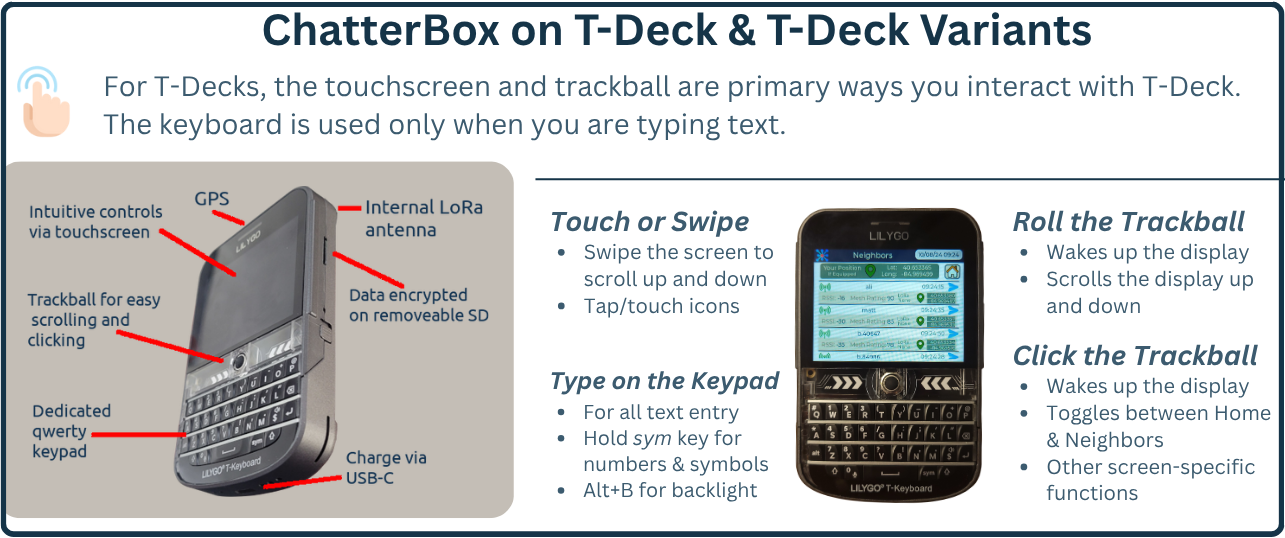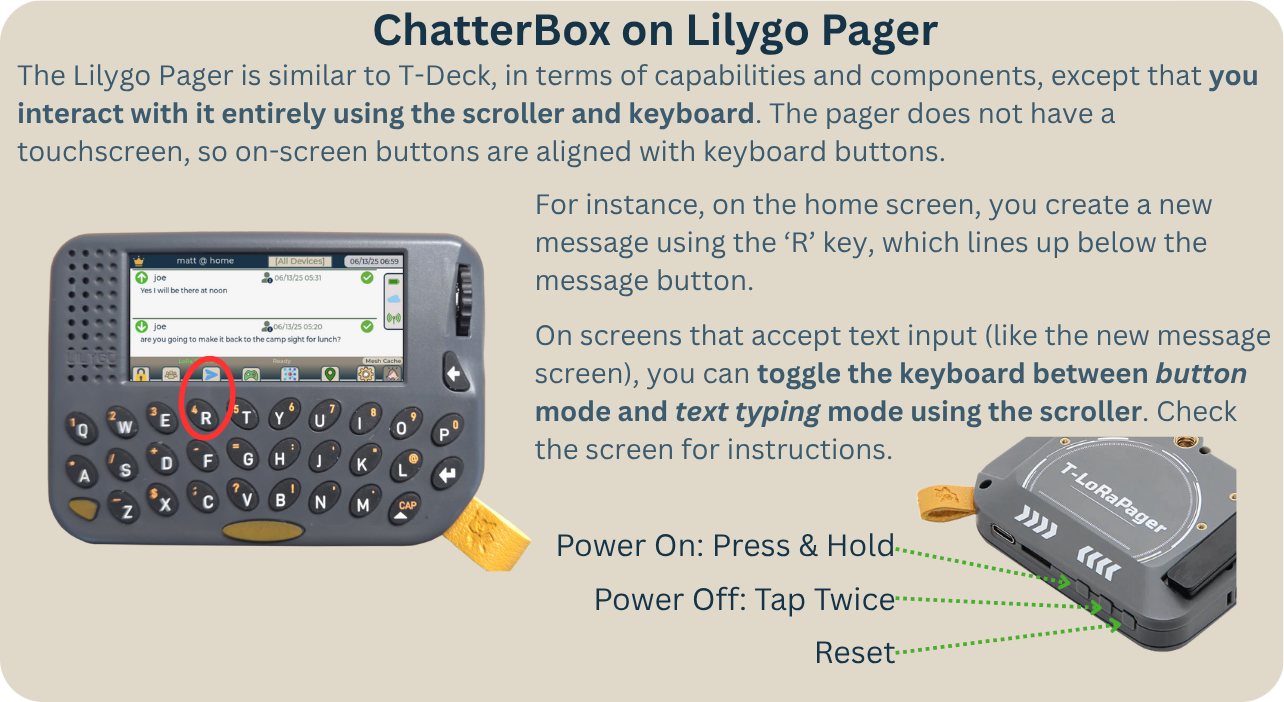ChatterBox: Text Securely Off-Grid
Independent of infrastructure & centralized services (cell/internet/grid)
Local messaging, broadcasts, & location sharing with trusted people
Smart decentralized mesh algorithm intelligently moves packets as efficiently as possible, while maintaining security
Out-of-range / powered-off devices can receive messages up to 24 hours later
Encrypted and digitally signed (asymmetric/symmetric encryption + ECDSA)
Delivery confirmations when a message is received
Unpredictable frequency hopping + packet striping across frequencies
Buy a fully custom secure mesh comms cluster from us. Built to your needs, ready to run, right out of the box.
We can build your cluster
Already have a T-Deck or Pager?
Download ChatterBox firmware now. Build and easily expand your own cluster using our detailed DIY instructions.
ChatterBox Communicator Screens
How messages are delivered
Home
Latest messages, live connectivity, more
Neighbors
Currently in-range devices, live locations
Buy a fully custom secure mesh comms cluster from us. Built to your needs, ready to run, right out of the box.
We can build your cluster
Download ChatterBox firmware now. Build and easily expand your own cluster using our detailed DIY instructions.
Already have a T-Deck?
Sending a Message
Choose a device, type a message, send
Location
Live or last-known location for any device
Get your Own ChatterBox Cluster Now!
We can build and configure your ChatterBox cluster, so all you have to do is turn it on! Or, you can build it yourself, and learn a lot about mesh technology.
If you have unique requirements not met by any of our custom kits or firmware, contact us - almost anything is possible.
Buy Directly From Us
Buy pre-built/pre-configured hardware and cluster kits directly from us!
You choose and name devices, we configure everything
Licensed devices with our firmware pre-installed
Build Your Own Cluster
Acquire or build your own devices from various sources and install ChatterBox firmware.
See hardware options for running ChatterBox firmware
Download firmware and detailed PDF build instructions
Learn More
Learn about our protocol, advanced meshing, security features, and how to use ChatterBox
Learn about ChatterBox, see firmware demos, watch a build
Download user guides, technical docs, and more
Using ChatterBox
ChatterBox is designed for anyone to be able to just pick up and use, intuitively. You don’t need to understand encryption, RF, configure a bunch of settings, or have an amateur radio license. You don’t need any app or phone!
Transfer SD Card Between Devices
If you are using SD cards (recommended), you can move a T-Deck’s SD card over to a pager (and vice versa). It will carry over all settings, messages, and password protection.
How messages are delivered
Learn more
Buy a custom-built cluster
Build your own cluster
How ChatterBox Delivers
Even to Powered Off Devices
Broadcast: Message blasts securely across your cluster
Direct: Instant via RF (LoRa)
Mesh: Your cluster works together
Technical
Good place to start if you want to know more.
All messages, locations, and other sensitive information is encrypted during transmission and at rest
All transmitted information is digitally signed, including messages, locations, pings, and delivery confirmations.
Both use LoRa, send messages, and utilize some of the same hardware. That’s where the similarities end.
For enhanced security and anti-jamming, ChatterBox clusters/channels hop unpredictably.
Learn how ChatterBox keeps time synchronized throughout the cluster, even in the absence of grid and GPS
We can build your cluster
Buy a fully custom secure mesh comms cluster from us. Built to your needs, ready to run, right out of the box.
You choose devices, we configure everything. They will arrive ready to run, right out of the box, with no setup needed.
Download ChatterBox firmware now. Build and easily expand your own cluster using our detailed DIY instructions.
Already have a T-Deck?
-
Don't wait until it's too late to get a backup off-grid comms solution
Get your secure comms solution in place

-
Learn about the ChatterBox firmware and hardware
Read more at: chatters.io/support and offgridcomms.club

-
Follow our blog to stay up to date on product developments



























